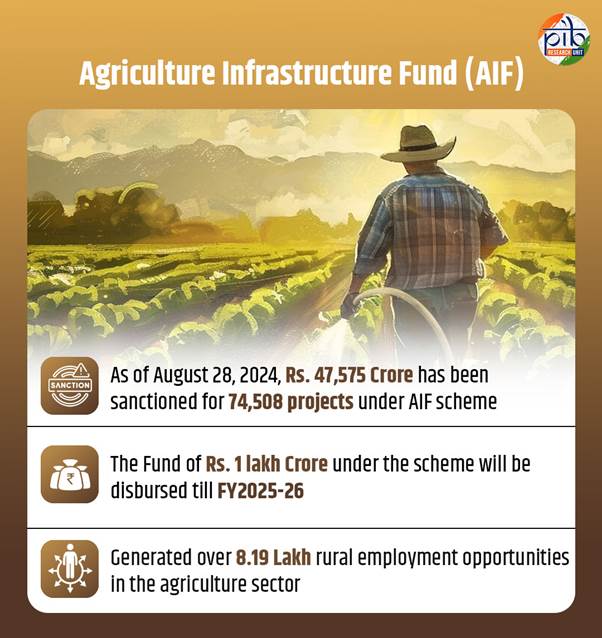Agriculture Infrastructure Fund (AIF)
Agriculture Infrastructure Fund (AIF)
The Agriculture Infrastructure Fund (AIF) is a transformative Central Sector Scheme launched in 2020 to revolutionize India’s agricultural infrastructure and post-harvest management capabilities. With a substantial allocation of ₹1 lakh crore over 13 years (2020-21 to 2032-33), the scheme aims to bridge critical gaps in farm-gate storage, logistics, and processing infrastructure.
Scheme Overview and Objectives
The AIF represents a comprehensive medium to long-term debt financing facility designed to mobilize investments in viable projects for post-harvest management infrastructure and community farming assets through interest subvention and credit guarantee support. The scheme’s primary objectives include:
Enhancing post-harvest management infrastructure to minimize crop losses and improve farmer incomes
Facilitating modern packaging and cold storage systems enabling farmers to sell produce on favorable terms
Increasing private investments in the agricultural sector through attractive financing options
Reducing national food wastage percentage through improved storage and processing facilities
Leveraging new-age technologies like IoT and AI for agricultural innovation
Connecting agri-entrepreneurs and startups with funding opportunities
Eligible Beneficiaries
The scheme adopts an inclusive approach, welcoming diverse stakeholders in the agricultural ecosystem:
Individual Farmers and Farmer Groups
Farmer Producer Organizations (FPOs)
Primary Agricultural Credit Societies (PACS)
Marketing Cooperative Societies
Self Help Groups (SHGs) and Joint Liability Groups (JLGs)
Multipurpose Cooperative Societies
Agri-entrepreneurs and Startups
National and State Federations of Cooperatives
Central/State agency or Local Body sponsored Public-Private Partnership Projects
Exclusions: Public Sector Undertakings (PSUs) are not directly eligible, though PPP projects sponsored by them qualify for support.

Financial Framework and Benefits
Loan Structure
Aggregate Loan Facility: ₹1 lakh crore from various lending institutions
Interest Rate Cap: Maximum 9% per annum on loans
Loan Quantum: Up to ₹2 crore covered under guarantee and subvention; higher amounts considered but without scheme benefits
Repayment Period: 7 years with flexible repayment based on project cash flow
Moratorium: 6 months to 2 years (interest payable during moratorium)
Key Financial Incentives
Interest Subvention: All loans receive 3% per annum interest subvention up to ₹2 crore limit for maximum 7 years. For loans exceeding ₹2 crore, subvention applies only to the first ₹2 crore.
Credit Guarantee Coverage: Comprehensive coverage under Credit Guarantee Fund Trust for Micro and Small Enterprises (CGTMSE) for loans up to ₹2 crore, with government bearing the guarantee fee.
Enhanced Coverage (2024 Expansion): NABSanrakshan Trustee Company Pvt. Ltd. now provides additional credit guarantee coverage for FPOs, expanding financial security options.
Eligible Projects and Infrastructure
Post-Harvest Management Infrastructure
Storage Facilities: Warehouses, silos, cold stores, and cold chain facilities
Processing Units: Primary processing centers, grading, sorting, and cleaning facilities
Packaging and Value Addition: Packing units, ripening chambers, waxing plants
Logistics Infrastructure: Reefer vans, insulated vehicles, supply chain services
Community Farming Assets
Advanced Farming Systems: Hydroponic farming, mushroom cultivation, vertical farming, aeroponic farming
Protected Cultivation: Polyhouse/greenhouse infrastructure
Smart Agriculture: Infrastructure for precision agriculture and IoT-enabled farming
Custom Hiring Centers: Shared mechanization facilities
Specialized Infrastructure
Organic Input Production Units: Bio-stimulant production, nurseries, tissue culture facilities
Quality Infrastructure: Assaying units, testing laboratories
Marketing Platforms: E-marketing platforms, private mandis
Recent Expansions and Enhancements (2024)
The Union Cabinet approved significant expansions to the AIF scheme in August 2024, making it more comprehensive and inclusive:
Viable Farming Assets Expansion
All eligible beneficiaries can now create infrastructure for viable community farming assets, enhancing collective farming capabilities and sustainability.
Integrated Processing Projects
The scheme now includes integrated primary and secondary processing projects, though standalone secondary projects remain under Ministry of Food Processing Industries schemes.
PM-KUSUM Convergence
Component-A of PM-KUSUM scheme can now converge with AIF for farmers, FPOs, cooperatives, and panchayats, promoting sustainable clean energy solutions alongside agricultural infrastructure.
Enhanced Credit Guarantee
NABSanrakshan Trustee Company Pvt. Ltd. provides additional credit guarantee coverage for FPOs beyond existing CGTMSE coverage, strengthening financial security.
Implementation Mechanism
Participating Financial Institutions
The scheme operates through a robust network of lending institutions including:
24 Scheduled Commercial Banks
40 Scheduled Cooperative Banks
Regional Rural Banks (RRBs)
Small Finance Banks and NBFCs
National Cooperative Development Corporation (NCDC)
NABARD with special provisions for PACS
Monitoring and Evaluation Framework
The government employs a comprehensive multi-tiered monitoring mechanism to ensure effective implementation and impact assessment:
Technology-Enabled Monitoring
AIF Online MIS Portal: Real-time project tracking from sanction to implementation
Geo-tagging: Physical progress monitoring and regional distribution assessment
AI and Data Analytics: Impact analysis on yield improvements and post-harvest loss reduction
Third-Party Assessment
Independent Field Evaluations: Agro-Economic Research Centre (AERC) Pune conducted comprehensive impact studies
Stakeholder Consultations: Regular feedback mechanisms with banks and state governments
District and State-Level Committees: Localized monitoring and alignment with regional needs
Performance and Impact Assessment
Infrastructure Creation
Since its launch, AIF has demonstrated remarkable success in infrastructure development:
6,623 Warehouses constructed nationwide
688 Cold Storage Units established
21 Silos Projects completed
Additional Storage Capacity: Approximately 500 LMT (465 LMT dry storage + 35 LMT cold storage)
Financial Performance
₹47,575 Crore Sanctioned for 74,508 projects as of August 2024
₹78,596 Crore Total Investment Mobilized in agriculture sector
₹78,433 Crore Private Investment attracted through the scheme
Socio-Economic Impact
8.19+ Lakh Rural Employment Opportunities generated in agriculture sector
18.6 LMT Food Grains can be saved annually through improved storage
3.44 LMT Horticulture Produce preservation capacity added
State-wise Allocation Examples
The scheme provides tentative state-wise allocations based on agricultural output ratios:
Maharashtra: ₹8,460 crore allocation
North-Eastern States: ₹3,516 crore total allocation, with Assam receiving ₹2,050 crore
Convergence and Integration
The AIF scheme demonstrates strong convergence with multiple government initiatives:
State and Central Government Schemes: Integration with AMI, ACABC, PMEGP, NHB, MIDH programs
PM-KUSUM Scheme: Component-A convergence for clean energy solutions
CGTMSE Integration: Credit guarantee support for micro and small enterprises
NABSanrakshan Convergence: Enhanced FPO support mechanisms
Project Limitations and Eligibility Criteria
Project Scale
Maximum Projects per Entity: Up to 25 projects at different locations
Minimum Promoter Contribution: 10% of project cost mandatory
Loan Coverage: Full scheme benefits available only up to ₹2 crore
Non-Eligible Activities
Standalone Secondary Processing: Covered under MoFPI schemes
Government Sector: Direct PSU participation excluded
Residential or Commercial Infrastructure: Outside agricultural scope
The Agriculture Infrastructure Fund represents a landmark initiative in India’s agricultural transformation journey, providing comprehensive support for infrastructure development while ensuring financial accessibility and technical viability. Through its expanded scope and enhanced features, the scheme continues to strengthen India’s agricultural infrastructure ecosystem, supporting the government’s vision of doubling farmer incomes and achieving sustainable agricultural growth.
Source: PIB

